There have been four NPB players confirmed for posting in the 2025 offseason cycle with some big names included. Most famously, Munetaka Murakami, the Swallows slugger who created international buzz hitting 56 home runs as a 22 year old in 2022. He is joined by a fellow seasoned bat Kazuma Okamoto, and two Seibu Lions starting pitchers in ace Tatsuya Imai and Kona Takahashi.
Let's jump into a detailed breakdown on each player as well as a potential future posting in Hiroto Saiki.
Confirmed Posting
Munetaka Murakami, 3B/1B
Yakult Swallows (Age 25)
Munetaka Murakami's profile is as volatile as they come. A hitter who has fully embraced the three true outcomes approach. Leading NPB in TTO% for three consecutive seasons from 2022 to 2024 among qualified hitters, blending patience and control of the zone with legitimate swing-and-miss concerns. His zone-contact rates have remained troubling since his debut, underscoring the risk in his offensive game.

What keeps Murakami's profile bolstered is his power, capable of producing towering home runs even in NPB's dead-ball era. Few hitters on the planet impact the baseball like he does. I first wrote about Murakami following his historic 56-homer season in 2022, a campaign that cemented his place as one of the most dangerous power bats in the world. His 2023 and 2024 seasons were more uneven.
Still, the quality of contact remained elite for most of the time, and his ability to consistently lift the baseball has continued to drive results. He hits the ball extremely hard with max exit velocities that dazzle, and he can hit pitches off-balance and off-time hard. All that said, he's a streaky hitter who can go bonkers and then have prolonged stretches of droughts at the plate, looking lost at times.
Pitchers will continue to bust him up and in while throwing offspeed and breakers away, where he's been poor making contact on breaking balls. He punishes mistakes, but there's genuine concern about his swing-to-swing contact. The initial setup in the box reminds me of Matt Olson, but he doesn't get his bat into the slot consistently the way Olson does, and Olson moved his bat into a more angled position over the years. A change in setup with his hands might help him get to better positions for higher velocity pitching.
Murakami 2022
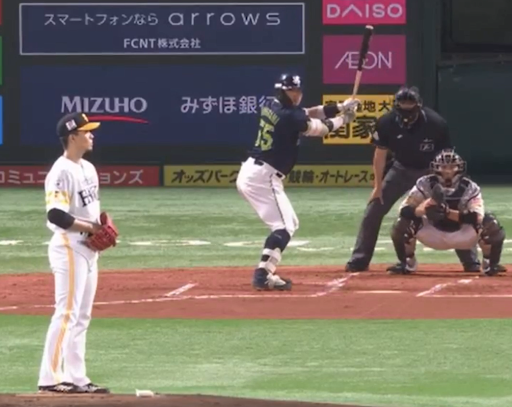
Olson 2022

Murakami 2025
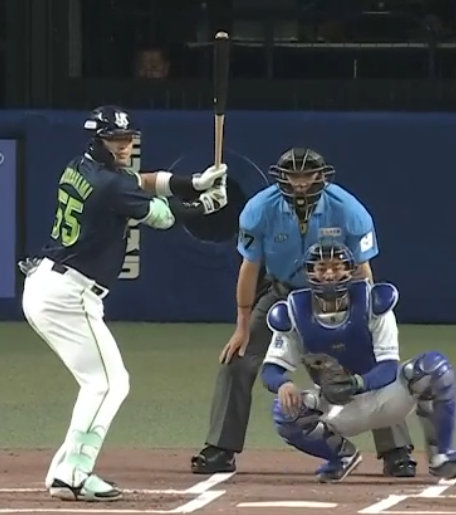
Olson 2025
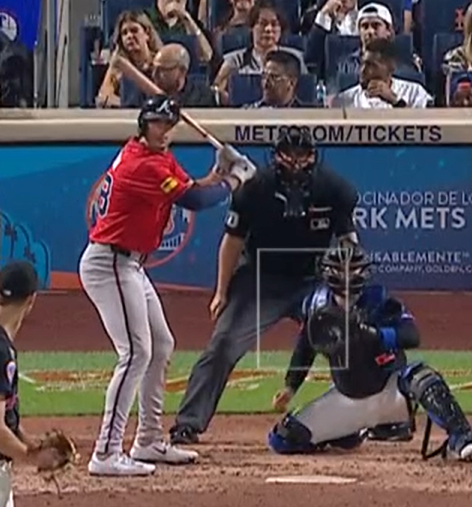
Defensively, Murakami's future is likely limited to first base or designated hitter, despite clubs possibly experimenting with him at third. Advanced defensive metrics, including Sports Info Solutions' NPB Defensive Runs Saved, paint a bleak picture of his glove ranking as one of the worst at 3B throughout his career, with consistently negative outcomes. As a result, much of his value will hinge on whether the bat can carry the profile.
An injury-shortened 2025 season didn't slow him down. Murakami launched 22 home runs in just 56 games, reaffirming the legitimacy of his power when he does connect. Ultimately, his transition to the MLB will depend on whether his low-contact, fly-ball approach can withstand the premium velocity of major league pitchers. If it does, Murakami has the potential to be a middle-of-the-order masher, but the type who might lead the league in strikeouts with 35+ home run power.
Tatsuya Imai, RHP
Seibu Lions (Age 27)
Tatsuya Imai is one of the premier pitchers in Japan, standing shoulder to shoulder with Cuban ace Livan Moinelo, diminutive lefty Hiroya Miyagi, and my personal favorite arm, Hiromi Itoh. Those four make up my top tier of starters in the country right now. What separates Imai from the rest is how he bullies hitters with a devastating fastball–gyro slider combo.
His gyro slider is unusual; it moves more arm-side than glove-side, producing an atypical, almost "reverse" slider or gyroball. The pitch dives under barrels when spotted glove-side and has become a genuine out pitch as he has gained confidence and command. Imai stays firmly behind the ball, generating nearly pure bullet spin that gives the slider a hint of arm-side tail, closer to a true gyroball than a traditional slider. Over the past three seasons, his steadily improving walk rate reflects the refinement in both his pitch mix and his strike-throwing consistency.
Slider at Release

Gyroball at Release




Working from the first-base side of the rubber and exclusively out of the stretch, the compact Imai delivers the ball almost like a middle infielder, low three-quarters slot, upright posture, and effortless velocity in the 93-96 mph range, touching the upper 90s. From this angle, his four-seamer shows strong arm-side run, and he looks to attack up in the zone early in counts, though he could stand to elevate it more consistently to maximize the pitch's vertical approach angle and flat angle from his low release height.
When ahead, he'll bury the slider down and glove side to right-handers, but is also comfortable back-footing it to lefties. His sequencing and locations are intentional: against right-handed hitters, he has the catcher set down and away to take advantage of his natural arm-side run, while versus left-handed hitters, he mixes both arm- and glove-side targets, seemingly focused on avoiding leaks back inside to right-handed bats.
Catcher Locations 2025
RHH
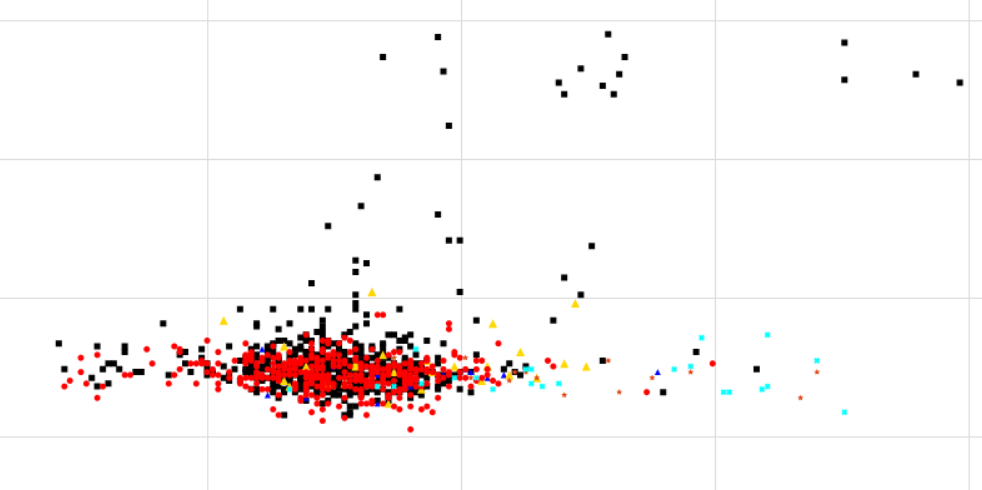
LHH
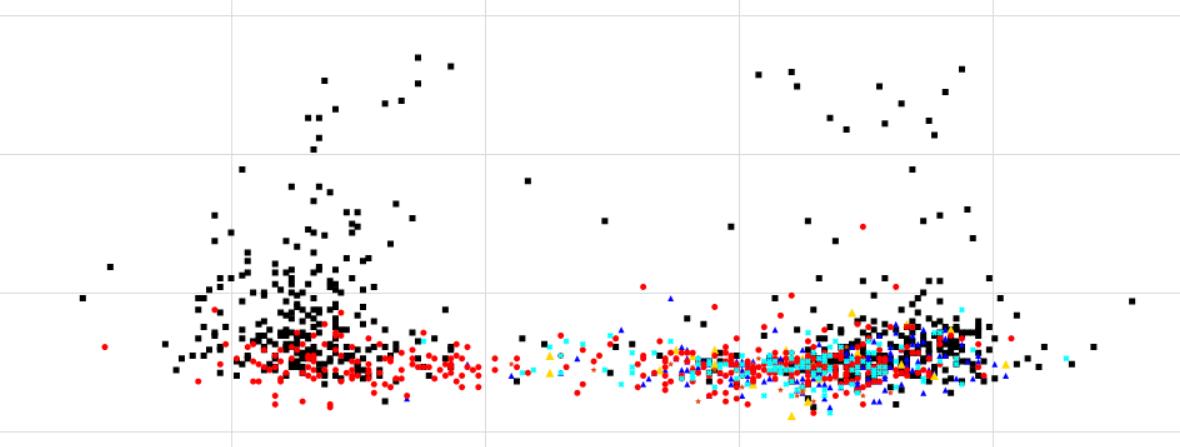
Though his bread and butter is the fastball-slider combo, Imai isn't a two-pitch pitcher. He'll flash a changeup, splitter, even a Vulcan change he experimented with for a stretch, plus a bigger, horizontal curveball. The whiff rates are eye-popping, and his pitches with the angles he creates should translate anywhere in the world.
Offspeed Grips
Vulcan Change
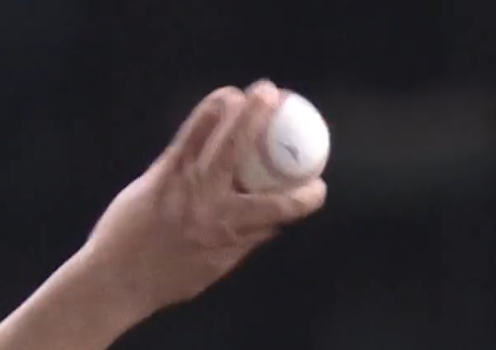
Splitter
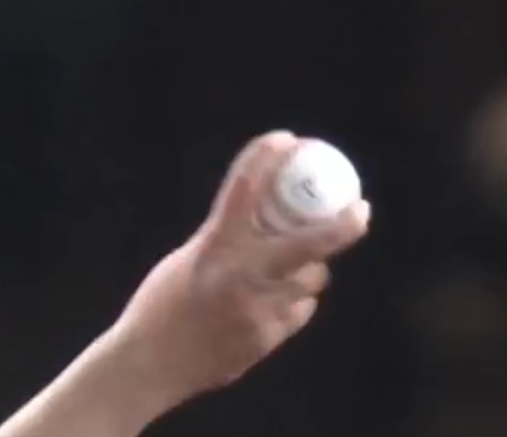
Three-Finger Change
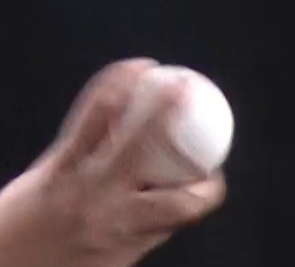
The only real question is whether the recent command gains hold. If they do, Imai's arsenal carries true mid-rotation upside in a definite rotation role as a No. 4 starter, because his success relies more on solid locations at key points. If the command backs up, he could be looking at more of a backend rotation spot or as a leverage bullpen piece with his fastball and slider combo. With both Imai and teammate Kona Takahashi getting posted this offseason, this would signal Seibu's chances of doing anything in 2026 as very low. However, Kaima Taira's rumored return to the rotation might soften the blow.
Kona Takahashi, RHP
Seibu Lions (Age 28)
Kona Takahashi has experienced both the mountaintop and the valley over the past few seasons. At his 2023 peak, he was one of Japan's best pitchers, finishing fifth league-wide in ERA (2.21) and posting a 143 ERA+. But his 2024 injury-marred season marked a steep decline, a 3.87 ERA, a 76 ERA+, and a winless 0–11 record over 15 starts. His strikeout rate dropped noticeably in 2024 and has continued to dip through 2025.

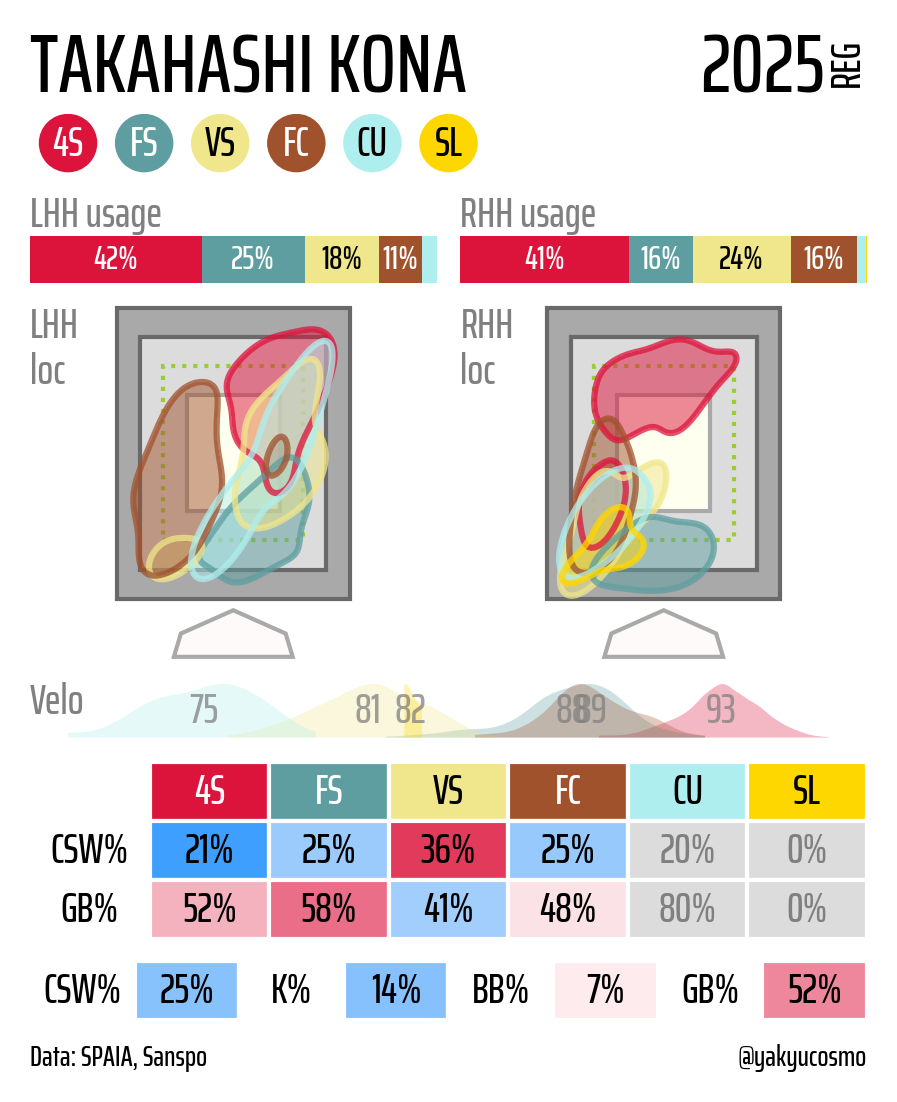

Takahashi works with a deep, versatile arsenal headlined by a splitter and a slurve/sweeper (in NPB categorized as a vertical slider). The splitter is a groundball weapon, consistently generating high groundball rates when at or below the bottom of the zone in location. His ability to limit damage has long been supported by Seibu's strong defense, suggesting that any MLB success will likely hinge on landing with a similarly sound defensive club.
The fastball is the most significant question mark. Thrown from a high three-quarters slot, it features below-average shape and carry, producing just a 10.4% whiff rate on his four-seamer in 2024 and 10.6% in 2023. In 2025, his four-seam whiff percentage dropped to an abysmally low 8.3%. By comparison, Naoyuki Uwasawa's two different fastballs generated an 18.3% whiff rate in 2023.
Still, Takahashi's velocity and depth of repertoire provide him a solid foundation to build upon. He typically sits around 93 mph but can reach 96–97 deep into starts. If he can maintain a more consistent mid-90s velocity, even in shorter bursts, that could help mitigate the below-average traits of his fastball. His command and sequencing are more advanced than Uwasawa's, and his overall mix is both deeper and slightly more dynamic outside of the four-seamer.
Takahashi also features a cutter that he can work to his glove side against both right-handed and left-handed hitters, and his slider-slurve pairing plays well together, with similar shapes but separated by enough velocity to disrupt timing. He'll occasionally mix in a bigger, more traditional curveball as a strike-stealing look early or late in counts. While he abandoned his two-seamer in 2025, Takahashi used it almost exclusively against same-handed hitters. He could reincorporate it again in MLB to diversify his fastball usage, but also possibly pull the four-seam usage down to below 40 percent for both handedness, which should help.
Ultimately, Takahashi will need to keep hitters guessing with his layered mix of breakers and a stretched velocity band. An MLB club investing in him is hoping that a one- or two-tick velocity bump across his arsenal can unlock backend rotation or, more likely, swingman potential. Right now, he's looking at a Minor League deal with a chance to get some run in the Majors, though it's likely a long shot.
Kazuma Okamoto, 1B/3B
Yomiuri Giants (Age 29)
Kazuma Okamoto has been one of the most consistent offensive performers in NPB, anchoring the heart of the lineup for Japan's most visible team, the Yomiuri Giants. Playing in Tokyo comes with a certain gravitas and expectation of excellence, and Okamoto has met that standard for years as one of the premier all-around hitters in Japan.
Other Notable Names at the top of the OPS+ Leaderboard:
- Munetaka Murakami - 199
- Terauki Sato - 186
- Luke Voit - 178
- Kensuke Kondoh - 171
- Seiya Hosokawa - 171

A left elbow injury shortened his 2025 season after an errant throw from third tailed into the runner as Okamoto extended for the ball at first base. When he returned, however, he went on a tear, leading NPB with a 212 OPS+ in 293 plate appearances (minimum 200 PA).
Among the top OPS+ leaders in 2025 were Japan's premier power bats and the best pure hitter in Japan, Kensuke Kondoh, yet Okamoto outpaced them all. He slugged 15 home runs in 69 games, posting a .327/.416/.598 line.
Okamoto's offensive skill set functions with a complete, all-fields approach. He punishes mistakes and takes his hits against better execution, while maintaining intent to do damage. He's naturally pull-oriented, logging a 44% pull rate in 2025 and 52% in 2024, but his approach remains under control. He's patient and will take his walks.
He prefers to work counts but can be a free swinger against non-fastballs, but he can spoil quality offspeed or breakers late when behind. While he has a lower swing percentage against fastballs, he absolutely demolishes hard velocity. According to @GaijinBaseball, Okamoto's career wRC+ against fastballs of 94 mph or higher is 157, and in 2025, it jumped to 269, both in smaller samples, though.
Mechanically, his swing is designed for lift, as his air-ball percentage has remained around 67% over the last three seasons. That swing plane, combined with his ability to access pull-side loft, should translate to valuable MLB production if he can continue to get to those same contact points against even higher velocity.
Kazuma Okamoto has the highest AIR% in NPB since 2021 at 67.3% (min. 1600 PA).
— Yakyu Cosmopolitan (@yakyucosmo) October 22, 2025
He also pulls it consistently and has a very similar batted ball profile to Seiya Suzuki.
Okamoto's estimated launch angle this season was 17.5°. Suzuki's was 17.9°.pic.twitter.com/lqk5szaFg4
In the box, Okamoto starts balanced and slightly crouched, hands set out front. Out of a medium leg kick, his hands stretch back into the slot as his front foot lands perpendicular to the plate, allowing for strong rotation without pulling off. The head stays quiet, and his movements create a clean path that covers the zone.
Defensively, Okamoto profiles more naturally as a first baseman than a third baseman, though he could handle the hot corner in a pinch, and Defensive Runs Saved numbers back that up. How an MLB team utilizes him will likely depend on the team's composition and needs. He also has innings in left field where he's been ok.
The Giants, like Hanshin, rarely post their stars. However, with rumors swirling, there was always a likelihood of Posting, and with confirmation that both Okamoto and Murakami are coming to the US. This offseason will be fun.
Overall, Okamoto profiles as a complete hitter whose offensive game could mirror Seiya Suzuki's once he adjusts to MLB pitching. Like Suzuki, Okamoto has started to maximize damage by lifting to his pull side, and both share the ability to hammer fastballs while maintaining disciplined at-bats and working walks.
Declined Posting, Worth Watching
Hiroto Saiki, RHP
Hanshin Tigers (Age 26)
Hiroto Saiki's profile carries some intrigue; he pairs a high-carry fastball with a delivery that creates natural rhythm, timing disruption, and notable extension. He struck out seven in a spring outing against the Dodgers, showcasing a four-seamer that's flashed over 20 inches of induced vertical break from a high three-quarters slot. The shape is excellent, even if the whiff production doesn't entirely match the visual quality.
Saiki's four-seamer generates an above-average whiff rate in NPB, 15% in 2025 and 13.1% in 2024, with better results against left-handers than right-handers. The pitch should still translate for some swing-and-miss success in MLB, given its carry and shape, though it remains somewhat underperforming in terms of actual bat-missing output.
Mechanically, Saiki starts with a slight heel raise on the rubber, transitioning into a leg lift that reaches chest height before dropping smoothly to belt level in rhythm. He features a brief pause, then counter-rotates his hips as he brings the knee back toward his body and curls it before driving forward. He rides his hip down the mound well, staying closed, and steps directly to the plate, though his shin angles slightly toward the glove side at foot strike. His long extension helps the fastball play up further. There's some upper-body tilt and head movement at release, but nothing alarming, especially given Saiki's consistent strike-throwing history.

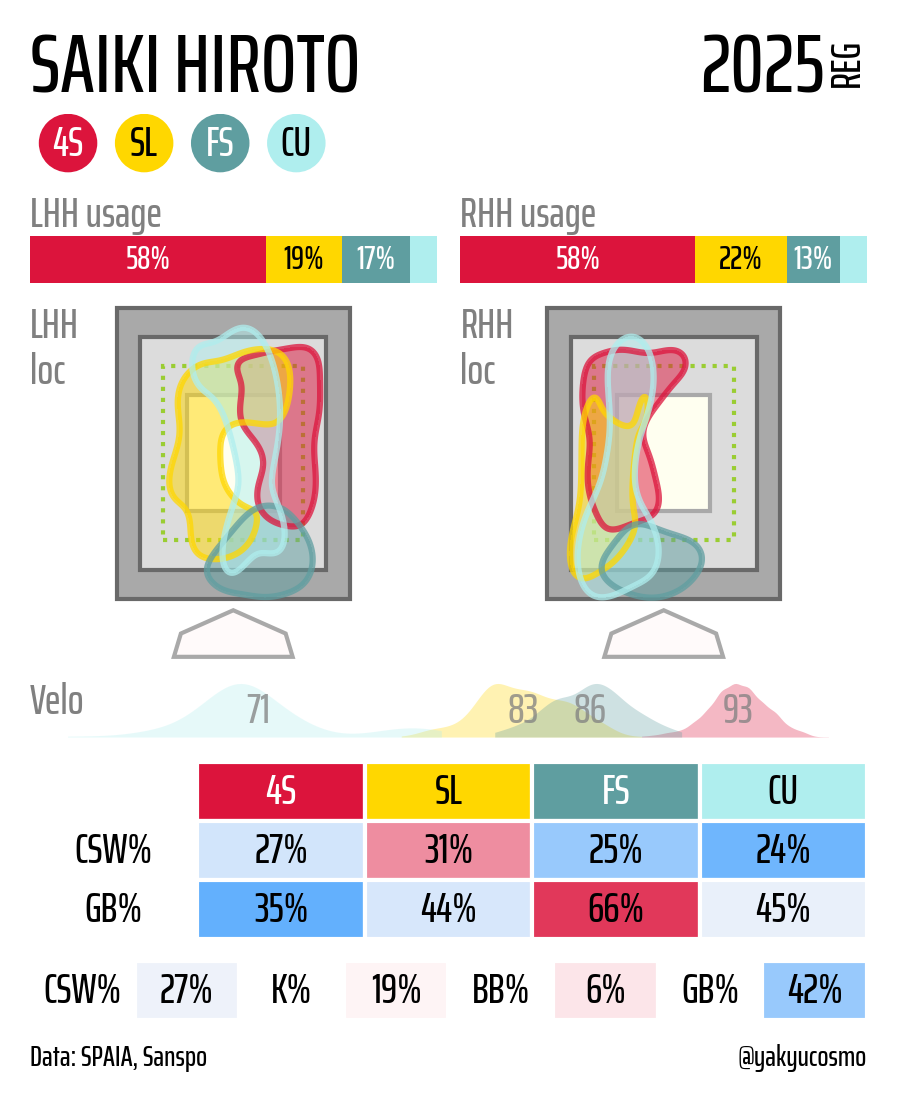

The rest of his arsenal is quirky. His best secondary pitch is an 84-88 mph splitter that dives to the dirt, with occasional accidental cuts when he's not on top of the ball, resulting in unpredictable, sometimes funky movement. He also mixes in two glove-side breakers: a cutter/slutter around 85 mph and a slower, more traditional slider around 80 mph, though the distinction is more about velocity band than shape.
He'll also occasionally flip in a rainbow curveball in the low 70s and upper 60s as a pure change-of-pace pitch. Saiki will likely need to refine his glove-side shapes to create more whiff-finding impact stateside with less reliance on his four-seamer, which he overuses.
Splitter Grip

Even so, Saiki has proven capable of producing consistent results and could project as a backend starter or long-relief arm option with clear groundball tendencies and innings-eating potential. The Hanshin Tigers have historically been reluctant to post their stars; yet, the fact that Saiki's name continues to surface in posting rumors suggests his profile has gained meaningful traction. He's a name to keep an eye on for future seasons.
All the data in this article is from @yakyucosmo and his website, yakyucosmo.com
Also, @bouno05 and his NPB Pitch and Bat Profiler App
Other data gathered from work at Sports Info Solutions















Discussion